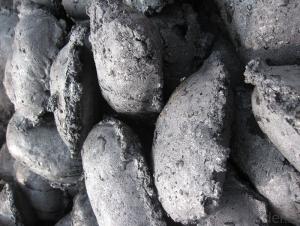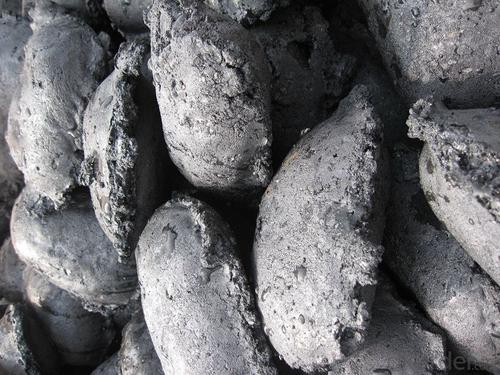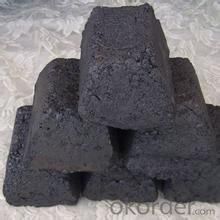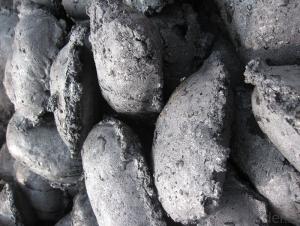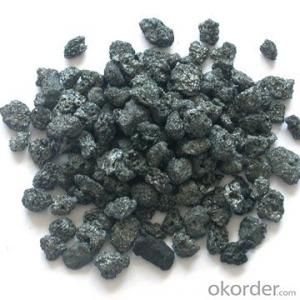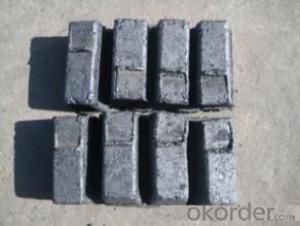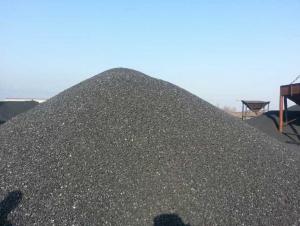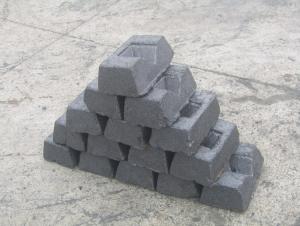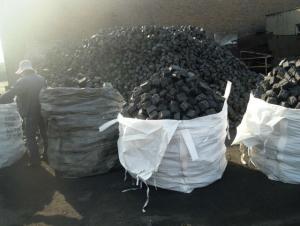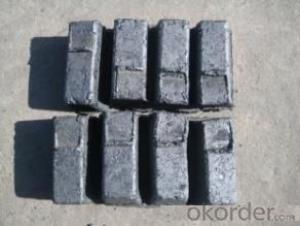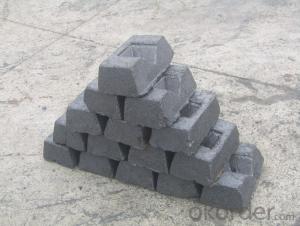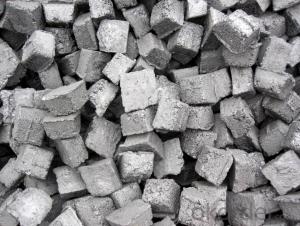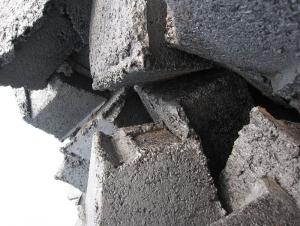Carbon Electrode Paste for felloally production
- Loading Port:
- Lianyungang
- Payment Terms:
- TT OR LC
- Min Order Qty:
- 20 m.t.
- Supply Capability:
- 800 m.t./month
OKorder Service Pledge
OKorder Financial Service
You Might Also Like
Spcifications
1:carbon eletrode paste
2:for ferroalloy,calcium carbide manufacture
3:HS 3801300000,YB/T5212-1996,ISO9001:2008
Product Description
Carbon Electrode Paste is a self-baking electrode used in submerged arc furnaces for delivering power to the charge mix. Electrode Paste is added to the top of the electrode column in either cylindrical or briquette form. As the paste moves down the electrode column the temperature increase causes the paste to melt and subsequently bake forming a block of electrically conductive carbon. Electrode Paste is essentially a mix of Electrically Calcined Anthracite (ECA) or Calcined Petroleum Coke (CPC) with Coal Tar Pitch.
Graphite/Carbon Electrode Paste Specification:
| PARAMETER UNIT GUARANTEE VALUE | ||||||
| Ash.( % ) | 4.0 max | 5.0 max | 6.0 max | 7.0 max | 9.0 max | 11.0 max |
| V.M (%) | 12.0-15.5 | 12.0-15.5 | 12.0-15.5 | 9.5-13.5 | 11.5-15.5 | 11.5-15.5 |
| Compress Strength. | 18.0 min | 17.0 min | 15.7 min | 19.6 min | 19.6 min | 19.6 min |
| Specific Resistance | 65 max | 68 max | 75 max | 80 max | 90 max | 90 max |
| Bulk Density | 1.38 min | 1.38 min | 1.38 min | 1.38 min | 1.38 min | 1.38 min |
Picture:
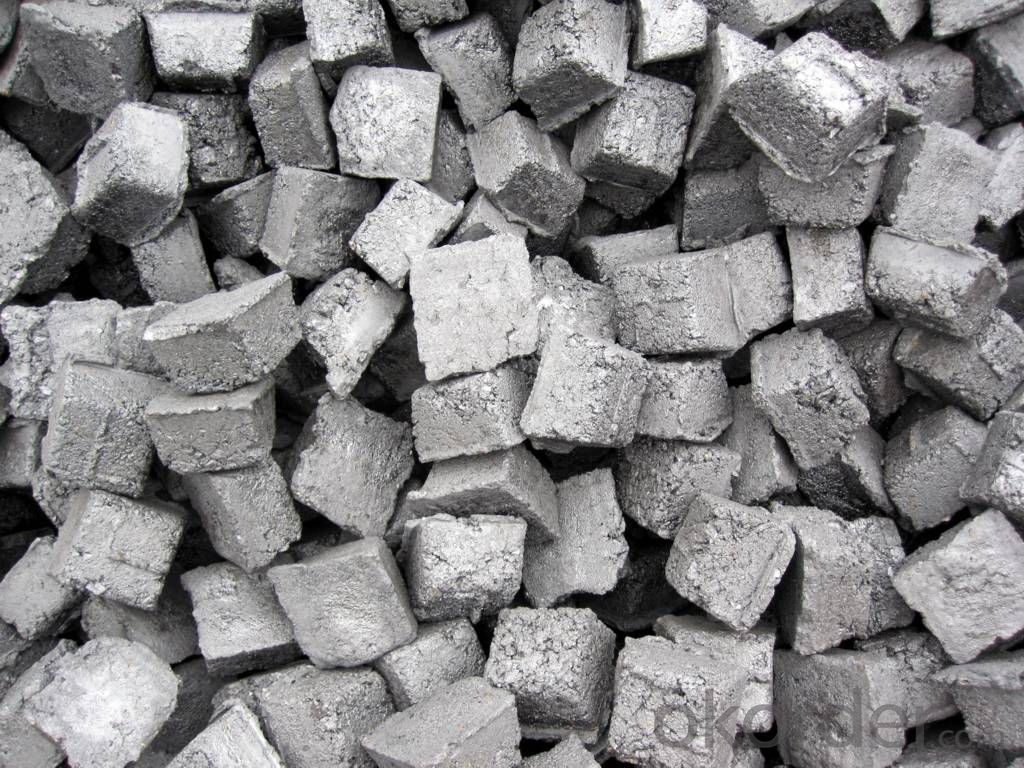
- Q: How does carbon impact the availability of clean water resources?
- Carbon impacts the availability of clean water resources in several ways. Firstly, the burning of fossil fuels releases carbon dioxide (CO2) into the atmosphere, contributing to climate change. This leads to rising global temperatures, which in turn affect the water cycle. Increased evaporation rates and altered precipitation patterns can result in droughts or excessive rainfall, both of which can disrupt the availability and quality of clean water sources. Additionally, carbon emissions contribute to ocean acidification, which harms marine ecosystems and disrupts the delicate balance of marine biodiversity, ultimately affecting the quality and availability of freshwater resources.
- Q: How does carbon contribute to the hardness of steel?
- Carbon contributes to the hardness of steel through a process known as carbonization. When carbon atoms are introduced into the iron lattice of steel, they create interstitial solid solutions, causing the lattice to become distorted. This distortion prevents the iron atoms from sliding past each other easily, thereby increasing the resistance to deformation and making the steel harder. Increasing the carbon content in steel increases the strength and hardness, up to a certain limit. However, excessive carbon can also make the steel brittle, so it is important to find the right balance to achieve optimal hardness without compromising other properties of the steel.
- Q: What are the properties of activated carbon?
- Activated carbon, also known as activated charcoal, possesses several unique properties that make it highly versatile and useful in various applications. 1. Adsorption: One of the most significant properties of activated carbon is its high adsorptive capacity. It has a vast internal surface area due to its porous structure, which allows it to effectively adsorb molecules, ions, and impurities from gases, liquids, and solids. This adsorption capability makes it ideal for purification purposes, such as water and air filtration, as well as in the removal of toxins and pollutants from industrial processes. 2. Porosity: Activated carbon has a highly porous structure with a network of interconnected pores. This porosity provides a large surface area, enabling it to trap a significant amount of contaminants. The pores can be classified into three types: micropores (less than 2 nm), mesopores (2-50 nm), and macropores (greater than 50 nm), each contributing to its adsorption capacity. 3. Chemical Stability: Activated carbon exhibits excellent chemical stability, making it resistant to degradation and breakdown when exposed to various chemicals or environments. This property allows it to maintain its adsorption capacity over a long period and under harsh conditions, ensuring its efficiency and longevity in different applications. 4. Selectivity: Activated carbon can be tailored to exhibit selectivity towards specific substances by modifying its surface properties. Through various activation processes, such as physical or chemical treatments, the surface chemistry of activated carbon can be altered to enhance its affinity for certain molecules or contaminants, while reducing its affinity for others. This selectivity makes it an effective material for specific applications, such as removing specific pollutants or capturing desired compounds. 5. Regenerability: Another advantageous property of activated carbon is its regenerability. After reaching its adsorption capacity, it can be regenerated by heating or washing with appropriate solvents, allowing it to be reused multiple times before replacement. This regenerability not only reduces the operational costs but also contributes to its sustainability and eco-friendliness. 6. Low Density: Activated carbon has a relatively low density, making it lightweight and easy to handle. This property enables its use in various systems and devices without adding excessive weight or bulk. 7. Thermal Stability: Activated carbon possesses high thermal stability, allowing it to withstand high temperatures without significant degradation. This property makes it suitable for applications involving high-temperature processes, such as gas purification or catalytic reactions. Overall, the properties of activated carbon, including its adsorption capacity, porosity, chemical stability, selectivity, regenerability, low density, and thermal stability, make it a versatile material widely used in water and air purification, gas separation, chemical processing, pharmaceuticals, and many other industries.
- Q: Joint carbide gas incident
- After a lapse of 25 years, a India District Court on 1984 Bhopal gas leak to be long in coming judgment, Union Carbide (India) Co., Ltd. 7 India nationals day was held for negligence causing death, they will face up to two years in prison. On the same day, hundreds of survivors, family members and environmentalists gathered around the courthouse to protest the court's decision that the perpetrators of the worst industrial disaster in twentieth Century were too light and too late. In 1969, Union Carbine Co established a Union Carbide in central India state of Bhopal Beijiao city (India) Co. Ltd., specializing in the production of aldicarb, carbaryl pesticide drops. The chemicals used in these products is called a methyl isocyanate poisonous gas. The early morning of December 3, 1984, this factory storage explosive liquid methyl isocyanate the steel tank, 45 tons of poison gas leak quickly, directly killed more than 1.5 people, allegedly have caused more than 550 thousand people died and chemical poisoning related lung cancer, renal failure and liver disease.
- Q: Advantages of carbon fiber
- Carbon fiber has excellent properties of elemental carbon, such as small proportion, excellent heat resistance, small thermal expansion coefficient, high thermal conductivity, good corrosion resistance and good conductivity. At the same time, it has a kind of fiber like flexibility, which can be woven and wrapped. The best performance of carbon fiber is that the specific strength and specific modulus are more than that of general reinforcement fiber.
- Q: Paint paint fluorocarbon paint which expensive?
- Paint is divided into two categories, a class of low temperature baking paint, curing temperature of 140 degrees -180 degrees, and the other category is called high temperature baking paint, its curing temperature is 280 degrees -400 degrees.High temperature baking also known as Teflon (Teflon) English called Polytetrafluoroetylene, referred to as Teflon, PTFE and F4. High performance special Teflon coating is fluorine coating resin with polytetrafluoroethylene, English name for Teflon, because the pronunciation of reason, commonly known as Teflon, Tie Fulong, Teflon, Teflon and so on (all Teflon transliteration).
- Q: What are the applications of carbon nanowires?
- Carbon nanowires have a wide range of applications across various fields due to their unique properties and characteristics. Some of the key applications of carbon nanowires are: 1. Electronics: Carbon nanowires can be used as conducting channels in electronic devices, such as transistors and interconnects. Their high electrical conductivity, small size, and ability to carry high current densities make them ideal for use in nanoelectronics. 2. Energy storage: Carbon nanowires can be utilized in energy storage devices, such as batteries and supercapacitors. Their high surface area and excellent electrical conductivity enable efficient charge and energy storage, leading to enhanced performance and longer life cycles. 3. Sensors: Carbon nanowires can be used as sensing elements in various types of sensors. Their high sensitivity to changes in temperature, pressure, or gas concentration makes them suitable for applications in environmental monitoring, healthcare, and industrial sensing. 4. Biomedical applications: Carbon nanowires show promise in biomedical applications, including drug delivery systems and tissue engineering. They can be functionalized with specific molecules to target and deliver drugs to specific cells or tissues. Additionally, their high mechanical strength and biocompatibility make them suitable for scaffolds in tissue engineering applications. 5. Nanoelectromechanical systems (NEMS): Carbon nanowires can be used to construct NEMS devices, which are miniature mechanical systems that operate at the nanoscale. These devices have applications in sensing, actuation, and data storage, and carbon nanowires provide the necessary mechanical and electrical properties for their operation. 6. Nanocomposites: Carbon nanowires can be incorporated into various materials to enhance their mechanical, electrical, and thermal properties. They can reinforce polymers, ceramics, and metals, leading to improved strength, conductivity, and heat dissipation in the resulting nanocomposites. 7. Optoelectronics: Carbon nanowires can be utilized in optoelectronic devices, such as photodetectors and light-emitting diodes (LEDs). Their high electron mobility, low electrical resistance, and ability to emit light make them suitable for applications in displays, lighting, and optical communications. Overall, the applications of carbon nanowires are diverse and expanding, with the potential to revolutionize fields such as electronics, energy storage, sensing, biomedicine, and more. Continuous research and development in this area are expected to uncover even more exciting applications in the future.
- Q: What are the impacts of carbon emissions on the stability of kelp forests?
- Carbon emissions have significant impacts on the stability of kelp forests. Increased carbon dioxide (CO2) levels in the atmosphere lead to ocean acidification, which has detrimental effects on kelp. As CO2 dissolves in seawater, it forms carbonic acid, lowering the pH of the ocean. This acidification inhibits the growth and development of kelp, making them more vulnerable to stressors and reducing their overall stability. Ocean acidification affects the physiology of kelp in several ways. It hampers their ability to take up essential nutrients, such as nitrogen and phosphorus, which are crucial for their growth. This nutrient limitation weakens the kelp, making them more susceptible to diseases, predation, and damage from storms. Additionally, acidified seawater can hinder the development of kelp spores, impairing their ability to reproduce and regenerate kelp forests. Furthermore, carbon emissions contribute to rising sea temperatures, which also have detrimental effects on kelp forests. As the climate warms, kelp may experience thermal stress, leading to reduced growth rates and increased mortality. Warmer waters can also favor the growth of harmful algae species, which can outcompete kelp for space and resources, further destabilizing kelp forests. The stability of kelp forests is crucial as they provide numerous ecosystem services. They act as important carbon sinks, absorbing and storing large amounts of carbon dioxide from the atmosphere. Kelp forests also provide habitat and nursery grounds for a wide variety of marine species, including commercially important fish and invertebrates. They help maintain the health and productivity of coastal ecosystems by reducing coastal erosion, improving water quality, and supporting biodiversity. To mitigate the impacts of carbon emissions on kelp forests, it is essential to reduce our carbon footprint by transitioning to cleaner and more sustainable energy sources. Additionally, protecting and restoring coastal habitats, including kelp forests, can enhance their resilience to climate change and other stressors. Implementing sustainable fishing practices and establishing marine protected areas can also help preserve and maintain the stability of kelp forests and the valuable ecosystem services they provide.
- Q: What are the effects of carbon emissions on the stability of desertification?
- Desertification is significantly impacted by carbon emissions, which arise from human activities such as burning fossil fuels and deforestation, releasing carbon dioxide and other greenhouse gases into the atmosphere. These emissions contribute to the global warming phenomenon, which in turn leads to various adverse effects on desertification. One major consequence of carbon emissions is the alteration of precipitation patterns. As the planet warms, the evaporation rate rises, causing more moisture to be held in the atmosphere. Consequently, there is reduced rainfall in numerous regions, particularly in arid and semi-arid areas that are already prone to desertification. The scarcity of water exacerbates the dry conditions, thereby facilitating and intensifying desertification. Additionally, the higher temperatures resulting from carbon emissions contribute to the acceleration of soil erosion. As the land heats up, it becomes more susceptible to erosion caused by wind and water. This erosion leads to the loss of topsoil, which is vital for plant growth and stability. Without a stable layer of topsoil, vegetation struggles to establish and survive, ultimately causing the expansion of deserts. Furthermore, carbon emissions also impact plant communities' health and productivity. While increased levels of carbon dioxide can stimulate plant growth in certain cases, it often results in the proliferation of invasive species that are better adapted to the changing conditions. These invasive species outcompete native plants, diminishing biodiversity and further destabilizing the ecosystem. Additionally, as desertification progresses, the loss of plant cover reduces the capacity to sequester carbon, leading to even higher carbon dioxide levels in the atmosphere. In conclusion, carbon emissions have detrimental effects on desertification's stability. They disrupt precipitation patterns, accelerate soil erosion, reduce plant productivity, and diminish the capacity to sequester carbon. To mitigate these impacts and prevent further progression of desertification, it is crucial to reduce carbon emissions through sustainable practices and conservation efforts.
- Q: What is the importance of carbon dating in archaeology?
- Carbon dating is of utmost importance in archaeology as it plays a crucial role in determining the age of artifacts and archaeological sites. This scientific method allows archaeologists to establish a chronological framework and understand the timeline of human history. The technique of carbon dating relies on the fact that all living organisms contain a certain amount of radioactive carbon-14, which decays at a predictable rate over time. By measuring the amount of carbon-14 remaining in an artifact or organic material, archaeologists can calculate its age. This method is particularly useful for dating organic remains, such as bones, charcoal, and plant fibers, which are often found at archaeological sites. The importance of carbon dating lies in its ability to provide a precise and reliable estimation of an artifact's age. This information is crucial for interpreting and understanding the context and significance of archaeological finds. By assigning an accurate date to an object or site, archaeologists can establish connections between different artifacts, societies, and cultures. This, in turn, helps to reconstruct ancient civilizations and their development over time. Furthermore, carbon dating is also valuable for refining and validating historical timelines. It allows archaeologists to cross-reference and verify the dating of artifacts and sites using other dating methods, such as dendrochronology (tree-ring dating) or stratigraphy (the study of rock layers). The combination of multiple dating techniques enhances the accuracy and reliability of archaeological interpretations. Carbon dating also assists in identifying and distinguishing between genuine artifacts and forgeries. By analyzing the age of an object, archaeologists can determine if it aligns with the historical context it claims to belong to. This is particularly important in the field of art and antiquities, where the market for fakes and forgeries can be lucrative. Overall, carbon dating is a vital tool in archaeology as it allows researchers to establish the chronology of ancient civilizations, validate historical timelines, and identify genuine artifacts. It provides valuable insights into our past, helping us better understand and appreciate the rich tapestry of human history.
Send your message to us
Carbon Electrode Paste for felloally production
- Loading Port:
- Lianyungang
- Payment Terms:
- TT OR LC
- Min Order Qty:
- 20 m.t.
- Supply Capability:
- 800 m.t./month
OKorder Service Pledge
OKorder Financial Service
Similar products
Hot products
Hot Searches
